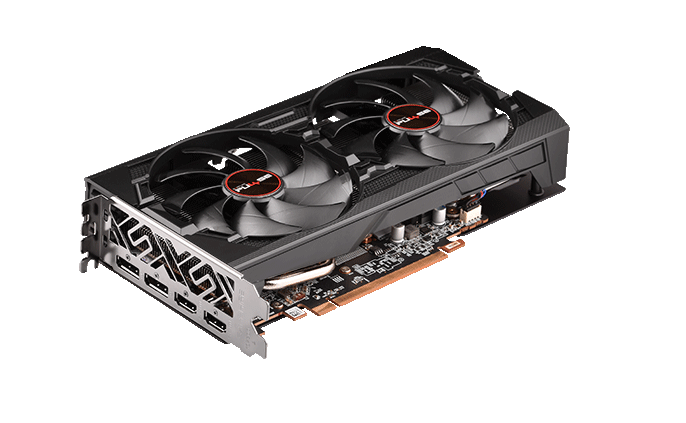Sapphire Expands its RX 5600XT Lineup With Cheaper Pulse BE Variant
Dropping the clock speeds is the latest trend.

The AMD Radeon RX 5600XT has been out for quite some time now, but that doesn't mean that the card isn't getting any more love. On the contrary: Sapphire is coming out with a new variant called the RX 5600XT Pulse BE, which is similar to the original RX 5600XT Pulse (covered in the linked review above), but with slightly lower clock speeds as spotted by VideoCardz.
| Header Cell - Column 0 | RX 5600XT Pulse BE | RX 5600XT Pulse |
|---|---|---|
| GPU | Navi 10 | Navi 10 |
| GPU Cores | 2304 | 2304 |
| Game Clock | 1560 MHz | 1615 MHz |
| Boost Clock | 1620 MHz | 1750 MHz |
| Memory | 6 GB GDDR6, 192-bit | 6 GB GDDR6, 192-bit |
| Memory Speed | 14 Gb/s | 14 GB/s (with BIOS update) |
It's worth noting that the new Pulse BE variant comes with two DisplayPort connectors and two HDMI ports, whereas the old non-BE card packed the standard I/O suite, which consists of three DisplayPort connectors and one HDMI port.
The Sapphire RX 5600XT Pulse BE comes with a dual-fan cooler that uses a copper cold plate, heatpipes and a mid-sized fin stack to handle cooling.
At the end of the day, the differences brought by the new card mostly come down to a lower clock speed, but that's not so bad if the price is right. MSI recently "refreshed" their GeForce GTX 1650 AERO ITX 4G OC with an OCV1 model, also featuring a slower clock speed.
Currently the Sapphire RX 5600XT Pulse retails for $290 on Amazon, so with some luck this one will drop the price.
Stay On the Cutting Edge: Get the Tom's Hardware Newsletter
Get Tom's Hardware's best news and in-depth reviews, straight to your inbox.
Niels Broekhuijsen is a Contributing Writer for Tom's Hardware US. He reviews cases, water cooling and pc builds.
-
Alvar "Miles" Udell Sapphire releases a slower 5600XT, MSI releases a slower GTX 1650...As if these cards weren't slow enough already!Reply -
cryoburner Reply
The typical 5600 XT is in a similar performance range as last generation's GTX 1080 and the current RTX 2060, and is arguably a reasonable option for 1440p or high-refresh rate 1080p gaming. I wouldn't exactly call it "slow". Considering how close the performance of the 5600XT is to the 5700, I would have rather seen AMD not increase the clock rates just prior to launch, and instead cut the price to around $250 to have a product more evenly positioned between the 5500XT and the 5700. Even this card will still exceed the originally planned "game clock" for factory overclocked cards by 100 MHz and it still uses the higher-clocked memory, so performance should be relatively similar to the other factory overclocked cards. It's just not overclocked quite as high as some other models, but is still clocked well above reference specs.Alvar Miles Udell said:Sapphire releases a slower 5600XT, MSI releases a slower GTX 1650...As if these cards weren't slow enough already!
The 1650, on the other hand, is only about half as fast, and needs settings turned down a fair amount in the most demanding games just to get 60fps at 1080p. So, it could be considered a bit slow, especially considering other cards like the 1650 SUPER and RX 580 are around 30% faster for a similar price. I guess it has relatively low power draw going for it though, which could be useful for prebuilt systems with low-end PSUs. -
King_V I was also under the impression that when testing was done with the RX 5600XT (experimenting with increasing just the clocks that would be given with the new BIOS, then just the memory speed increase, then both, versus the pre-release speeds) that most of the gains were seen from the memory clock increases.Reply
Slightly disappointing that it's going for the SAME price as the original, faster Sapphire Pulse did at release.
Either way, the 5600XT is NOT a slow card, and it's not fair to describe it as such. Unless you're going to turn around and also call the RTX 2060, GTX 1660, GTX 1660 Super, GTX 1660Ti, GTX 1070, GTX 1070Ti, and GTX 1080 slow cards.
The "even slower GTX 1650 with GDDR5" on the other hand . . uh, no idea why that is. Unless they plan to sell them at a particularly low price. I don't think there's really a niche of "a second card that is slower than the RX 570, but costs more" that Nvidia needed to fill.
Most Popular




